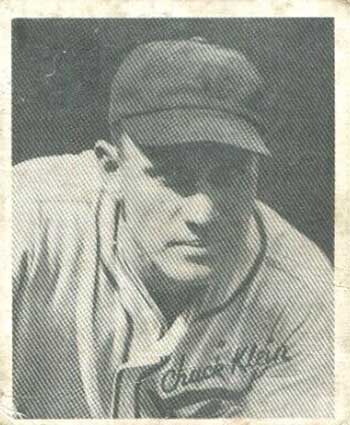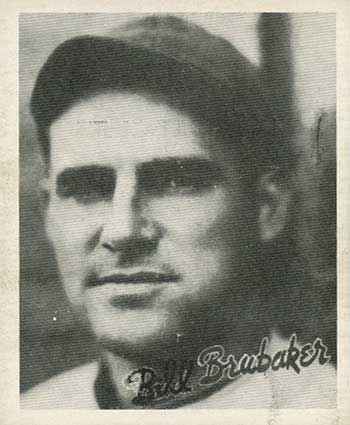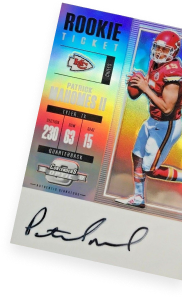1936 Goudey Baseball: Accentuate the Positives
1936 Goudey Baseball has a harder time standing out than its predecessors.
Goudey’s inaugural baseball card issue was released in 1933 and became an instant hit. Its popularity
has only grown over the years, and today, the release lands somewhere on the Mount Rushmore of sets for many collectors. With four Babe Ruth cards, two cards of Lou Gehrig, a missing short print in the card of Nap Lajoie, and virtually every other recognizable star from the era, its prestige is easily understood.
After that initial set, however, Goudey’s annual releases shrunk in size and there are good reasons for the lessened interest. The 1934 set was a smaller, less important remix from the 1933 series. And the 1935 issue was like the final part in a trilogy that was no longer necessary.
All three sets used virtually the same artwork and got progressively worse.
For 1936 Goudey Baseball, the company opted for a complete reboot.
1936 Goudey Baseball History
While the cards maintained the same square-like appearance as before, the style of pictures changed drastically. Instead of using colorful art depictions of players, Goudey countered with real black and white photographic images. Developing a card that looked vastly different than the others was certainly a good idea. But today, the set is routinely viewed as one of Goudey’s least popular releases.
For starters, the set was the smallest one yet with a checklist of only 25. But more importantly, the player selection has always been a point of criticism.
So why should collectors bother with it? Despite the set’s negatives, there’s actually a lot to like here.
The 25 cards make it the easiest of the Goudey sets to build by a mile. In fact, if you’re looking for a mainstream pre-war set to construct without spending big bucks, this is the one to target. It is a desirable build not only because low-grade commons are affordable, but also because even the most expensive card in the set (Hank Greenberg) can be found starting around $100-$150. That is a far cry from the four-figure Ruth and Gehrig Goudeys found in earlier releases.

The affordability is a big positive and so are the intriguing back variations that were intended to be used as part of a game.
In addition to a standard player biography, the backs also reference particular baseball actions to indicate what happens on a specific play. And if you count all of the backs, there are a total of 176 different cards in a master set.
A verified checklist of all back variations was not even publicly known to the hobby until just recently. An effort to create one is found in a 2012 thread on the popular Net54 message board website that is frequented by collectors of vintage cards. Matthew Glidden, a heavy collector of the 1936 Goudeys, remembers a 175-card checklist being built before he found a 176th (one featuring Clyde Castelman) and, what is believed to be, final card. Soon after, in 2016, Glidden began his pursuit of a master set. The quest wasn’t one that was finished overnight.
“I purchased my 176th variation (the 7th Hank Greenberg) in mid-2023, so it took about seven years,” Glidden recounts. “At least 100 cards came from eBay and the remainder from shows or fellow collectors.”
It might be intriguing to consider which players or back variations are harder to find. However, according to Glidden, the breakdown between players and back variations seem to be fairly even.
“(The) 1936 (Goudey cards) appear in about equal numbers across all players. There are 25 different fronts and 25 different backs, with most players containing seven variations,” Glidden adds. “Two stars (Lefty Gomez and Chuck Klein) come with eight and one journeyman (Buck Newsom) just six.”
Where’s Babe, Gehrig, Feller and DiMaggio?
Speaking of ‘stars,’ now is a good time to address the elephant in the room. 1936 Goudey Baseball is often criticized for the lack of stars in it. But how much of that is justified and is it really true?
When it comes to the biggest of names, the set certainly is lacking.
However, that point should be kept in some perspective, too.

Babe Ruth is not found in the set but he retired in 1935. Joe DiMaggio also doesn’t appear, but he was only a rookie in 1936. Astute collectors know that DiMaggio did in fact appear in Goudey’s Wide Pen photo premium set that year. But that issue also had a much larger checklist compared to the 1936 Goudey card set, which featured only 25 cards. Pitching phenom Bob Feller was also left out, but he, too, was a first-year player. There’s no Lou Gehrig, either. However, after Goudey replaced the popular “Lou Gehrig says” cards with “Chuck Klein says” cards in the high number series of the 1934 set, it is possible that he and the gum manufacturer were not doing business together at the time.
While there are solid explanations or theories why some of those players were not included, however, there are some head-scratching absenc- es, too. The likes of Jimmie Foxx, Dizzy Dean, and Mel Ott, perhaps most notably, are nowhere to be seen. That trio is notable since they appeared in earlier Goudey sets – and in the cases of Foxx and Dean, they are found in all three prior Goudey releases. Why none of those players made the cut for 1936 is unclear.
Thus, the release is certainly missing some of the true icons of the era. However, putting the checklist in context with the times helps show that it is maybe not as devoid of stars as is often suggested.
For one thing, there are some superstars to be had. A third-year card of Hall of Famer Hank Greenberg leads the way with those of others, such as Mickey Cochrane, Lefty Gomez, Paul Waner and a few other Hall of Famers. A total of eight Hall of Famers are in the set, which is roughly a third of the entire checklist.
There’s more, too. Another eight cards featured All-Star players, including Frank Crosetti, Pepper Martin, and Dolph Camilli. Some of the other All-Stars, such as Paul Derringer, Rollie Hemsley, Pinky Higgins and Bobo Newsom are regarded as commons. But that group combined for 18 All-Star appearances. There was also sure to be some excitement around another player whose cards are viewed mostly as commons – Wally Berger. A career .304 hitter, Berger was a top power hitter as a young player. He clubbed 38 home runs and hit .310 as a rookie in 1930. And his 34 home runs and 130 runs batted in led the league in 1935. Players like him made plenty of sense to include, even if their names do not resonate with collectors much today.
Despite the star players in the set, Glidden’s favorite card doesn’t feature any of those. He cites the card of Bill Brubaker’s as his favorite because of an error.
“Goudey used the wrong photo and it’s not Bill Brubaker,” Glidden explains. “It’s Dave Barbee, who last played several years earlier.” The photo irregularity, however, hasn’t done much to help the price of Brubaker’s cards. Those still typically sell as commons, in part because the mistake was never corrected.

How did the mistake occur?
“George Burke took Barbee’s original photo and either misnamed it as Brubaker or The Sporting News made a similar mistake on a version later obtained by Goudey,” Glidden suggests.
The mistake was identified on Twitter by Senior Curator at the Baseball Hall of Fame, Tom Shieber. Tom Barbee’s photo pictured him wearing a black armband worn by 1932 Pirates players in memory of owner Barney Dreyfuss. “Barbee last played that same year,” Glidden says, “so his reappearance as ‘Bill Brubaker’ in 1936 represents a nice bit of time travel. Other cards of Bill Brubaker, such as 1940 Play Ball #166, show the correct player.”
Player selection aside, an underrated aspect of the set is also seen in its rarity. Classifying the cards as ‘scarce’ is a bit of a reach. However, they are significantly harder to locate than Goudey’s 1933 and 1934 releases, and are also rarer than the quirky 4-in-1 set created in 1935. Based on that, one could come to the conclusion that the cards are a bit undervalued. Commons (and even the stars, for that matter) from the 1936 set do not usually sell for more than the ones in those earlier sets – even if they are harder to find.
Collectors seeking more of a challenge might take the path of Glidden in developing a master set. However, another option is the pursuit of the related Goudey Wide Pen photos issued in 1936 and 1937. Goudey’s 1936 card images were the same ones used in that series. However, that series also contains more than 200 cards that fit into several differ- ent types – some of which can be quite difficult to find.
For those seeking less of a Mount Everest climb, though, a basic version of 1936 Goudey Baseball fits the bill nicely. With only 25 cards and no real short prints, it is a legitimate mainstream baseball card set that can be easily constructed – despite that aforementioned rarity in comparison to its Goudey predecessors. The price is right, too, given the age. The set is nearly 90 years old and with low-grade commons starting around $10-$15, it can be built for under $1,000 with some patience.
1936 Goudey Baseball Checklist
25 cards.
Check 1936 Goudey Baseball values in the Beckett price guide.
Buy on:
1 Wally Berger, Boston Braves
2 Zeke Bonura, Chicago White Sox
3 Frenchy Bordagaray, Brooklyn Dodgers
4 Bill Brubaker, Pittsburgh Pirates
5 Dolph Camilli, Philadelphia Phillies
6 Clyde Castleman, New York Giants
7 Mickey Cochrane, Detroit Tigers
8 Joe Coscarart, Boston Braves
9 Frank Crosetti, New York Yankees
10 Kiki Cuyler, Cincinnati Red
11 Paul Derringer, Cincinnati Red
12 Jimmy Dykes, Chicago White Sox
13 Rick Ferrell, Boston Red Sox
14 Lefty Gomez, New York Yankees
15 Hank Greenberg, Detroit Tigers
16 Bucky Harris, Washington Senators
17 Rollie Hemsley, St. Louis Browns
18 Pinky Higgins, Philadelphia Athletics
19 Oral Hildebrand, Cleveland Indians
20 Chuck Klein, Chicago Cubs
21 Pepper Martin, St. Louis Cardinals
22 Bobo Newsom, Washington Senators
23 Joe Vosmik, Cleveland Indians
24 Paul Waner, Pittsburgh Pirates
25 Bill Werber, Boston Red Sox







